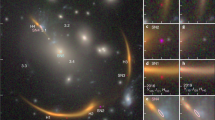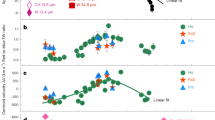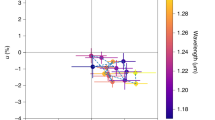Abstract
THE 8–13-μm flux from supernova 1987A has increased substantially1 since around May 1988 (∼ 450 days after the explosion), and the 8–13-μm source has been resolvable1, having a full width at half maximum of ∼1.5" in September 1988. This is attributed1 to re-radiation by an asymmetric circumstellar dust cloud, located mainly behind the supernova at a distance of ∼200 light days. This cloud may be related to the gas shell inferred from ultraviolet lines2,3. Here we extend the calculations of Roche et al.1 and consider the further implications of such a cloud. We conclude the following: the expected optical echo from the cloud (V-band magnitude mv ≲ 12) should be resolvable, and this, rather than an internal energy source (such as a pulsar), may cause the observed4–6 slowdown in dimming of the supernova; the reflected light may contribute substantially to the current optical luminosity; observations should be made as soon as possible, for the phenomenon may be evanescent; and the dust spectrum suggests that the dust is carbonaceous rather than silicaceous, although the circumstellar region is thought2 to be carbon-poor. This cloud behind the supernova may be truly interstellar.
This is a preview of subscription content, access via your institution
Access options
Subscribe to this journal
Receive 51 print issues and online access
$199.00 per year
only $3.90 per issue
Buy this article
- Purchase on SpringerLink
- Instant access to full article PDF
Prices may be subject to local taxes which are calculated during checkout
Similar content being viewed by others
References
Roche, P. F., Aitken, D. K., Smith, C. H. & James, S. D. Nature 337, 533–535 (1989).
Fransson, C. et al. Astrophys. J. 336, 429–441 (1989).
Sonneborn, G. et al. IAU Circ. No. 4685 (1988).
Hamuy, M., Suntzeff, N., Martin, G. & Gonzalez, R. IAU Circ No. 4680 (1988).
Burki, G. & Cramer, N. IAU Circ No. 4729 (1989).
Catchpole, R. M. & Whitelock, P. A. IAU Circ. No. 4751 (1989).
Chevalier, R. A. Astrophys. J. 308, 225–231 (1986).
Martin, P. G. Cosmic Dust Ch. 4 (Clarendon, Oxford, 1978).
Dwek, E. & Felten, J. E. Astrophys. J. (in the press).
Draine, B. T., preprint No. 213, Princeton Observatory (1987).
Savage, B. D. & Mathis, J. S. A. Rev. Astr. Astrophys. 17, 73–111 (1979).
Hamuy, M., Suntzeff, N. B., Gonzalez, R. & Martin, G. Astr. J. 95, 63–83 (1988).
Dwek, E. Astrophys. J. 274, 175–183 (1983).
Emmering, R. T. & Chevalier, R. A. Astrophys. J. 338, 388–402 (1989).
Dwek, E. Astrophys. J. 297, 719–723 (1985).
Draine, B. T. & Lee, H. M. Astrophys. J. 285, 89–108 (1984).
Edoh, O. thesis, Univ. Arizona (1983).
Couderc, P. Ann. Astrophys. 2, 271–302 (1939).
Masai, K., Hayakawa, S., Inoue, H., Itoh, H. & Nomoto, K. Nature 335, 804–806 (1988).
Wood, P. R. & Faulkner, D. J. IAU Circ. No. 4739 (1989).
Allen, D., Meikle, P. & Spyromilio, J. IAU Circ. No. 4747 (1989).
Karovska, M., Nisenson, P., Papaliolios, C., Standley, C. & Heathcote, S. IAU Circ. No. 4749 (1989).
Karovska, M., Nisenson, P., Papaliolios, C., Standley, C. & Heathcote, S. IAU Circ. No. 4752 (1989).
Heathcote, S., Suntzeff, N. & Walker, A. IAU Circ. No. 4753 (1989).
Crotts, A. & Kunkel, W. E. IAU Circ. No. 4741 (1989).
Crotts, A. & Kunkel, W. E. IAU Circ. No. 4753 (1989).
Nisenson, P., Papaliolios, C., Karovska, M. & Noyes, R. Astrophys. J. 320, L15–L18 (1987).
Felten, J. E., Dwek, E. & Viegas-Aldrovandi, S. Astrophys. J. (in the press).
Catchpole, R. M. et al. Mon. Not. R. astr. Soc. 237, 55P–68P (1989).
Author information
Authors and Affiliations
Rights and permissions
About this article
Cite this article
Felten, J., Dwek, E. Infrared and optical evidence for a dust cloud behind supernova 1987A. Nature 339, 123–125 (1989). https://doi.org/10.1038/339123a0
Received:
Accepted:
Issue date:
DOI: https://doi.org/10.1038/339123a0
This article is cited by
-
Far-infrared observations of thermal dust emission from supernova 1987A
Nature (1989)
-
The envelope thickens
Nature (1989)
-
Helium abundance and asymmetry in the wind from the precursor to supernova 1987A
Nature (1989)



